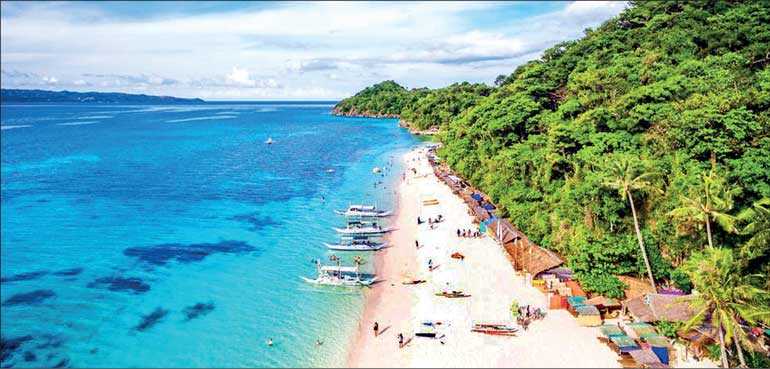Saturday Apr 20, 2024
Saturday Apr 20, 2024
Wednesday, 6 February 2019 00:00 - - {{hitsCtrl.values.hits}}

Sri Lanka has been ranked first in many ratings highlighting the best Asian country to visit in 2019. For so many years Sri Lanka had received amazing reviews and recognition, and now it finally got ranked first and is advertised extensively in magazines and travel blogs. We all know the beauty of Sri Lanka and the potential of this country to attract tourists and thus substantial income and benefits for the country as a whole.
What is highlighted by the visitors and bloggers are the natural beauties of this island, the natural and cultural heritage as well as the Sri Lankan people. One blogger highlights this in his comment: “My visit to Sri Lanka — a jewel-shaped country in the Indian Ocean — was an unexpected surprise. I didn’t have a lot of expectations for the trip. But it turned out to be an amazing experience. I loved every bit of Sri Lanka: the verdant landscape, the delicious food; the crumbling, overgrown ruins; the abundant wildlife; and (especially) the welcoming locals who took hospitality to the next level.”
Lonely Planet author Ethan Gelber mentions: “Already notable to intrepid travellers for its mix of religions and cultures, its timeless temples, its rich and accessible wildlife, its growing surf scene and its people who defy all odds by their welcome and friendliness after decades of civil conflict, this is a country revived.”
What he highlights as unmissable experiences are: wildlife, such as the 300-strong elephant gathering at Minneriya National Park, 1,000-year-old Buddhist monuments, and hiking and train travel through the hill country’s tea plantations.
Routes tourists take include nature, culture, food, wildlife, sports. Focus of interest is the multitude of possibilities to explore a country which has to offer so much. I have not encountered a blog or article which highlights the shopping possibilities or other entertainment possibilities around Colombo. Where Colombo has in that way still less to offer than metros such as Bangkok, Singapore, KL or Manila (where until recently the largest shopping mall of Asia was based), it also does not seem to be the focus of tourists at all when choosing an Asian country as their travel destination.
What is clear to many but not implemented enough yet is that without natural and cultural heritage Sri Lanka will be not even half of value to any visitor. And this does not even include the loss and disadvantage for all those who actually live here and call this country home.
Where one can list a number of challenges which this country is facing in terms of protection of natural habitat and a sustainable development of Sri Lanka, one can sum this all up into two priorities: despite the current trend, we need to protect the natural and cultural heritage from destruction by unsustainable developments within Sri Lanka and protect these heritages from destruction through tourists themselves.
The first one includes all those developments which are based on the current increased economic development of Sri Lanka (were tourism is only one reason) where various financial interests outweigh the protection of natural and cultural heritage. The second one includes really the question of which tourists do we want in Sri Lanka and how can a system be built which facilitates the protection of the natural and cultural heritage so that we do not face similar issues such as Boracay.
Boracay is an island in the Philippines which was once a highly-praised tropical beach destination, famous for its white untouched beaches and beautiful serene landscapes. Boracay was awarded the 2012 Best Island in the World by the international travel magazine Travel and Leisure, and in 2014 it was on top of the Best Islands in the World list which is published by the magazine Conde Nast Traveller. In 2016 the island headed the magazine’s Top 10 Destinations to Watch.
Only two years later, in 2018, the beach had to be closed for six months to undertake what the Government called renovation works. The various environmental challenges had taken its toll on the island, where tourist-related developments had gone out of control. In the meantime, it has reopened including a number of new rules to protect the island from more destruction.
This is only one example where uncontrolled tourism can lead to destruction and eventually loss for a country. The question is really, is it all about numbers or quality? We are proud to report about increasing tourist numbers but what does it really mean?
Where last year 2.1 million tourists visited Sri Lanka, the SL Tourism Development Authority mentions its hopes to double this by 2020. Where we already see that large-scale tourism-related developments are implemented at the cost of natural and cultural heritage, it seems that this trend is never-ending.
Various places across the island suffer from mismanagement of tourist influx, where national parks are overcrowded, habitat is destroyed by unsustainable tourist behaviour and there are hardly any consequences for those causing the harm. This cannot the way forward for Sri Lanka!
Where tourism can be a huge benefit for an entire nation, if done wrong, it can cause more harm than any profit it bring can balance out. A few might always benefit, but this cannot be the trend. Tourism has to be regulated by the State in a sustainable manner, controlling the impacts on natural habitat, on cultural heritage and also on the people’s welfare itself.
Sri Lanka is an example where the nation could benefit from sustainable tourism which can be hardly compared to other countries. It is heart-breaking to see how instead of reaping this possibility in the long term, in the name of fast financial returns the country’s heritage is destroyed bit by bit.